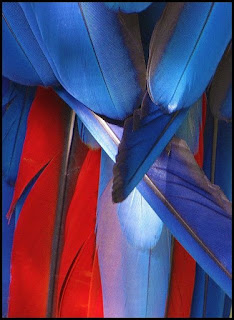living splashes of paint
as i write this from the nature haven of my friends' home, a stellar jay is stealing not only my attention but the sunflower seeds from the rest of the avian menagerie. i like to sit in front of the picture window, better than any nature show on tv, and watch the feeding unfold.
at least two hummingbirds live here and alternate between the syrup, rarely perching at the same time. juncos, sparrows, starlings, finches; the occasional squirrel...and, coffee in hand, i learned something new from an article my bird-loving pals left for me on the kitchen counter.
it's from the paper column "every day physics: by helen czerski; the color war of blue jays and cardinals". czerski teaches me about the science behind these beautiful birds.
red, like the brilliantly throated hummingbird, is visible to me because of pigment, a molecule that absorbs some colors and reflects others. a red pigment molecule will absorb the blues, greens, and yellows so that only the red is reflected back to our eyes. the absorption happens because of the structure of the molecule.
birds use pigments called carotenoids, which are common in many leaves and seeds, and tend to be reds, oranges and yellows. birds can't make these pigments, no animal can, and so they get them from their diet. a red bird is a living splash of paint, having transferred the pigment to its feathers.
pigments, however, never turn a bird blue. the color of blue in a jay, for example, comes from the architecture of the protein keratin that make up its feathers. the outer layer of keratin is full of tiny air pockets and, as light waves flood in, they bounce off the boundaries between air and protein.
blue light waves are short and, when they meet another blue light wave, they line up to reinforce each other which is why we see iridescence in feathers from every angle. blue light is the only light that escapes intact and, in the case of feathers, is called structural color.
(green parrots, snakes and frogs use both pigment and structural color)
who knew science could be so beautiful?
at least two hummingbirds live here and alternate between the syrup, rarely perching at the same time. juncos, sparrows, starlings, finches; the occasional squirrel...and, coffee in hand, i learned something new from an article my bird-loving pals left for me on the kitchen counter.
it's from the paper column "every day physics: by helen czerski; the color war of blue jays and cardinals". czerski teaches me about the science behind these beautiful birds.
red, like the brilliantly throated hummingbird, is visible to me because of pigment, a molecule that absorbs some colors and reflects others. a red pigment molecule will absorb the blues, greens, and yellows so that only the red is reflected back to our eyes. the absorption happens because of the structure of the molecule.
birds use pigments called carotenoids, which are common in many leaves and seeds, and tend to be reds, oranges and yellows. birds can't make these pigments, no animal can, and so they get them from their diet. a red bird is a living splash of paint, having transferred the pigment to its feathers.
pigments, however, never turn a bird blue. the color of blue in a jay, for example, comes from the architecture of the protein keratin that make up its feathers. the outer layer of keratin is full of tiny air pockets and, as light waves flood in, they bounce off the boundaries between air and protein.
blue light waves are short and, when they meet another blue light wave, they line up to reinforce each other which is why we see iridescence in feathers from every angle. blue light is the only light that escapes intact and, in the case of feathers, is called structural color.
(green parrots, snakes and frogs use both pigment and structural color)
who knew science could be so beautiful?


Comments
Post a Comment